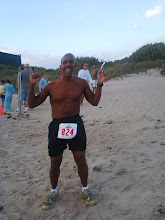Monday, May 27, 2013
Strength Variables:Speed
One of the variables in strength training is the speed of the activity.
This post is only about strength activities like power lifting or body weigh exercises, not speed activities like running or swimming. Nor is it about explosive activities like Olympic weightlifting or obstacle courses. However strength training will actually help all these activities as I've pointed out in previous posts.
There are 3 phases of most activities . There's the eccentric or down phase , often called the "negative". Then there's usually a static or isometric phase when there 's a pause. And finally there's the concentric motion or up phase .
These motions occur in almost all strength training, whether weights, kettle bells , or body weight training. How fast you control those motions will affect your strength.
For maximal strength , low rep slow strength like the military press or 1 leg squats, basically you want to train relatively slow. This doesn't mean crawling along but rather controlling the motion rather than letting the motion control you. This means don't rush the motion but proceed in a natural way.
Let's use the military press as an example. When you're ready, just start pressing the bar overhead at a normal pace. You don't have to count , just don't rush and push press or jerk it. This isn't supposed to be that type of lift. If you're using a reasonably heavy enough weight , you'll be forced to press at a natural speed . Press overhead all the way to lockout over the shoulders. Now pause for one or two seconds. Now do slowly lower the bar back down to your rack position.
Some quick notes. This rule applies whether to weights , dumb bells, kettle bells, suspension equipment, or even body weight exercises. Remember, this is about maximal strength. For high rep, strength endurance like regular push ups and pull ups, you can train the same way but because of the lighter load, ie less resistance, automatically the reps will be faster as well as more numerous. Again do control your speed, especially on the negative. Obviously there's no way you can hope to dead lift 400 lbs 50 times while 30 + pull-ups , even with a reasonable amount of weight, is definitely possible.
Remember, no training to failure. You may want to train small amounts through the day or low reps with many sets at once. In a test or competition you want to go as fast as possible. On the negative especially you don't want to waste energy controlling the rep. Nor do you want to pause more than a second at each lockout or completion . Just keep moving in good form.
Hopefully this post will help you on your strength quest. Remember the road to strength isn't in the fast lane.
Subscribe to:
Posts (Atom)
